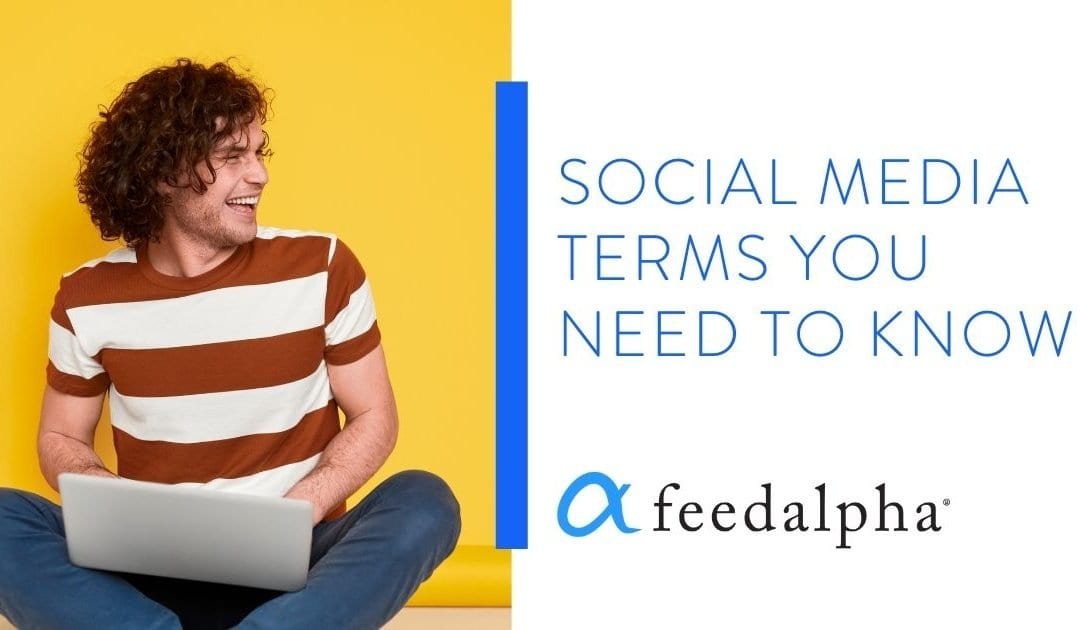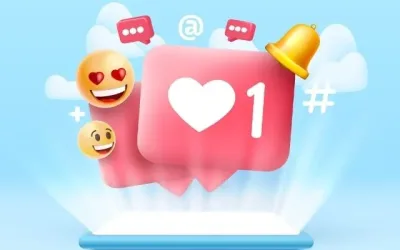The world of Social Media is incredibly fast-paced with new updates and features continuously released, so it’s critical that you stay active and in the loop. One way to do this is to understand the key terminology used across all platforms.
Here are our top Social Media terms you need to know.
Algorithm
Social Media platforms use algorithms to determine who sees what content and when. Essentially, they control your reach and results, so it’s important to keep track of how they work and follow any best practices that the platforms recommend.
Branding
You may be aware of branding from a traditional business sense, whether that’s business cards or your website, but this carries over to Social Media too. Everything that you share across Social Media, including your profile name, pictures and content, contributes towards your digital branding. You must keep this digital branding in line with the rest of your business and understand that Social Media is an extension of your brand.
Compliance
Compliance as a term means to ‘conform to a rule’, and in Marketing and Social Media, there are several. You may have heard of GDPR (General Data Protection Regulation), which means businesses must handle their customers’ data with care, including abiding by their marketing preferences. However, there are other forms of compliance on Social Media, including how you advertise financial information.
Conquest
A ‘conquest’ audience is made up of Social Media users that have likely little to no idea who you are or what you do. Now, this may seem like a pointless audience to target as you would assume conversion rates would be low but how do you expect to grow and expand your reach and brand awareness if you don’t actively aim to reach these people? The objective of conquest marketing is to start their customer journey and, eventually, convert them into customers.
Content
Your Social Media Content is everything from Facebook Posts to YouTube Videos and even your Blog. Content is used to describe the copy and creative you produce to encourage your audience to engage and learn more about your business.
Conversion
The ultimate business goal will always be to generate sales. When a potential customer takes the final step and purchases one of your products or services, this can be known as a conversion. Businesses tend to measure their marketing efforts based on conversions to see what customers are responding to best.
Creative
The images, GIFs or Videos used to accompany your marketing copy is called the creative. You must ensure this is relevant to your copy and on-brand as a business. Furthermore, your creative needs to be a suitable size depending on the Social Media platforms you’re posting on.
Emoji
Emojis are small digital images that people use to portray an emotion or action. There are now plenty of possible emojis to choose from to mix up your content.
Engagement
Although many couples do use Social Media platforms to share the happy news of their engagement, the word in a marketing sense means something slightly different. When it comes to Social Media, the term ‘Engagement’ is used to describe how your audience is interacting with you and your content. Likes, Comments, Shares, Retweets, Pins and Views are all forms of engagement.

Feed
You will hear the word ‘feed’ a lot in association with Social Media, and this is the stream of posts on your accounts. On Instagram, this could be referred to as your ‘Grid’.
Followers / Following
As the name suggests your Social Media’ Followers’ are users that follow your accounts to see your posts and engage with your content. On Twitter and Instagram, you can also ‘Follow’ users so that you too can engage and view content.
Handle
On Social Media, a ‘Handle’ is the @ name used on platforms like Twitter and Instagram. More often than not, the handle will be your business name, but this can be confusing because you have a username on these platforms too – which could also be your business name. The difference between the two is a handle is unique, and you will only find one version on either platform. Unfortunately, this may result in businesses having to add underscores and numbers to theirs if what they want is already taken.
Hashtag #
Hashtags may have started small on Twitter, but they’ve since taken over Social Media, and you’ll now find them on Facebook, Instagram and LinkedIn too. Using hashtags will group your posts with others using the hashtag and frequently used hashtags (over a short period) may even feature on Twitter’s ‘Trending’ list. Using hashtags in your content will increase your organic reach as users can follow specific hashtags.
Influencer
An Influencer, or Influencer Marketing, is a professional on Social Media who use their platform and audience to promote products on behalf of brands. The promotion could be for money or just for a free product.
Key Performance Indicator (KPI)
Businesses use KPIs to measure the success of an activity based on indicators such as historical insight or industry benchmarks. KPIs may differ depending on the industry and activity. KPIs in Social Media could be your cost per result on Ads or audience engagement rates.

Mention / Tag
A ‘Mention’ on Social Media is the same as a ‘Tag’. Users can use your ‘@’ handle on Twitter and Instagram or tag your page name in Facebook and LinkedIn so that you receive a notification and see their post. You can then tag or mention them back and continue the conversation.
Metrics
Social Media platforms will use different terminology for their results, whether it’s ‘Insights’ or ‘Analytics’. Still, all of them will disclose essential information on your reach, impressions and results – also known as ‘Metrics’. Metrics could also include KPI’s and Conversion rates.
Objectives
Your Social Media Objectives are like mini-goals or targets to complete on the platforms. This can be done through Paid Ads, where objectives could be to increase website traffic or to capture customer details. You can also meet objectives without using your marketing budgets, such as increasing your engagement and likes.

Organic vs Paid
As above, there are two ways of utilising Social Media platforms to reach your desired audiences. The first is ‘Organic’ which means you’re using the free features of the platform, and the second is ‘Paid’ where you can pay to promote your content through Ads.
Reach and Impressions
When it comes to results, ‘Reach’ speaks for itself – the number of users you have reached with a post. However, the reach can sometimes be confused with Impressions. Impressions are the number of times your content was shown on screen, rather than the number of people its reached. You can divide your total impressions by your total reach to calculate your frequency.
Reactions
You may have seen some Social Media platforms have moved away from a simple ‘Like’ and introduced a range of ‘Reactions’ instead. On Facebook, these reactions include Like, Heart, Hug, Laugh, Shock, Cry and Anger. On LinkedIn, in keeping with the different style of content, the reactions are Celebrate, Love, Insightful and Curious.
Retargeting
Facebook and Google allow you to track users on websites and use their data to reengage with them even once they’ve left your site. This is known as ‘retargeting’. A retargeted audience will be more likely to convert than a conquest one as they will know who you are and what you offer, making them a warmer lead.
Return On Investment (ROI)
Your return on investment can be calculated based on your objective to understand the effectiveness of your marketing efforts. For example, if you spend £100 on some Social Media Ads, it’s important to review how many leads you captured and ultimately how many sales. Your return on interest, among other influencing factors based on your business and marketing goals, will be used to plan your future marketing.
Scheduling
If you’re super organised, you can ‘schedule’ your Social Media posts in advance which will help ensure a consistent stream of content. Scheduling can be done using a third-party platform or manually within Facebook or Twitter.

Search Engine Optimisation (SEO)
SEO is the art of ‘optimising’ your website for higher search engine listings. The higher your website appears in search results, the more traffic you will receive. SEO covers everything from keywords to page loading times so it may be worth consulting an expert.
Share / ReGram / Retweet
If you’re using several Social Media platforms, then it’s essential to know the different terminology used, even if it pretty much means the same thing! When a user ‘shares’ your post, it means it will appear on their timeline for their friends and family to see, whether they follow you or not. A share on Facebook or LinkedIn is the same as a retweet on Twitter. Instagram currently only has a ‘Share To Story’ button, but users can download a second App and ‘ReGram’ a post which is a similar concept.
Social Listening
Social Listening is where businesses can monitor Social Media platforms for conversations about them, from customers and potential customers, their competitors or their industry in general. Social listening is critical as it allows businesses to ensure customer satisfaction, but it can also open up the opportunity to join conversations and increase brand awareness.
Sponsored Post
When businesses promote their posts with a dedicated budget through Social Media advertising, you will see a ‘Sponsored Post’ tag. This can also be known as ‘Boosting’ a post.
Stories
Instagram, Facebook and more recently, LinkedIn and Twitter all allow users to upload ‘Stories’ to their accounts that last just twenty-four hours. These stories can be made up of pictures or short video clips.
Tone Of Voice
Your tone of voice will be found in all areas of your business, such as the terminology used on your website and the way your employees converse with customers. It’s critical that you consider how this tone of voice will be received on Social Media. You need to keep your copy on brand and suitable to your target audience.
URL
A URL (Uniform Resource Locator) is the website link you can use in your Social Media posts to help drive traffic to your website. It’s recommended that you use a link shortener to create what’s called a ‘Vanity URL’ which keeps your posts looking more visually pleasing.
User-Generated Content
A popular form of content for businesses to share is ‘User-Generated Content’ (UGC). If your customers are tagging you in posts of them using your products or services then (with their permission), businesses can share this to their platforms to encourage others to choose them too. UGC may also be known as Customer or Consumer Generated Content.
Verified
You may have seen that some accounts on Twitter and Instagram feature a blue tick by their name, which means they are ‘verified’. The reason Social Media platforms verify accounts is to protect users from unknowingly engaging with fake accounts, thinking it’s a public figure or brand.
Webinar
A Webinar is like an online event, where a host can share slides or other multimedia content online, thus enabling audiences from anywhere in the world to join. Webinars tend to be live with an option for viewers to submit questions into a chatbox, but they are also often recorded and shared following the event.
Streamlining Social Media for Recruiters : A Comprehensive Guide
Social media has seamlessly integrated into our daily lives, as millions of individuals flock to various platforms to connect with others, information sharing, and pursue new opportunities. Within today's competitive job market, utilizing the power of social media...
Six Ways to use Social Media for Your Business
Are you tired of feeling like your business is missing out on potential customers? In today's digital age, social media has become an essential tool for businesses to connect with their target audience and grow their brand. From Facebook to Instagram, Twitter to...
Social Media Engagement Post Ideas To Increase Your Reach
Social media has become an essential part of our daily lives, and it's no longer just a platform to connect with friends and family. It's also a powerful tool for businesses to reach and engage with their audience. Engagement on social media platforms is crucial...





